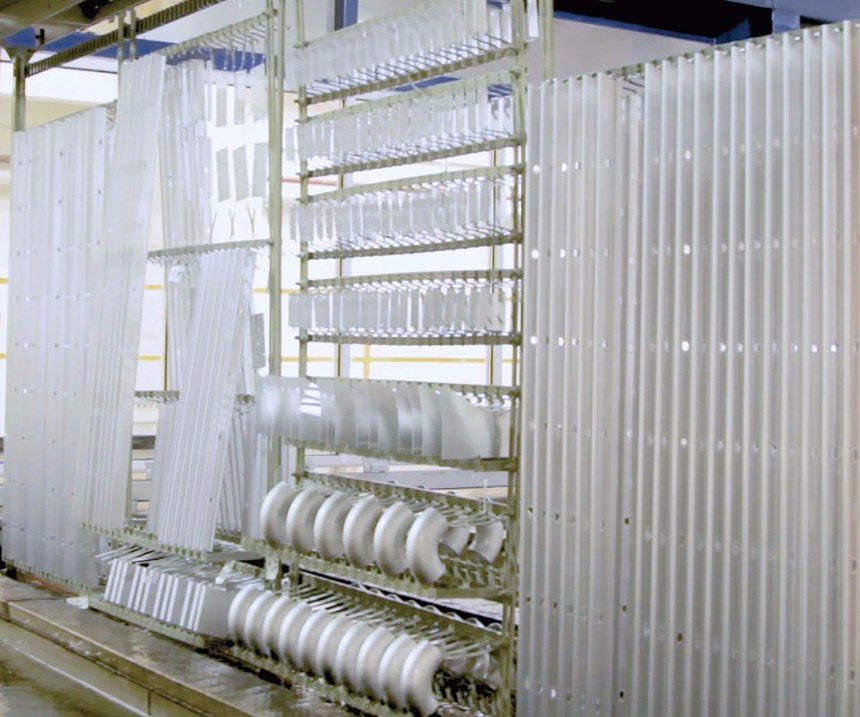Electrocoat Primer Takes Off in Aerospace
PPG’s Aerocron electrocoat system tops our list of the finishing products highlighted in 2017.
#aerospace
Applying a primer is an important step in the coating of metal parts. This initial coating allows paint to better adhere to the parts’ surface, and it provides corrosion and rust protection.
Electrocoating is widely used in the automotive industry to prime and paint car bodies, but there are additional challenges to using this technology for aerospace parts. PPG Aerospace has developed what it says is the first electrocoat primer system that specifically allows airframe manufacturers and subcontracts to coat parts for commercial, military and general aviation aircraft.
Featured Content
In November, PPG and Air Tractor welcomed aerospace industry representatives to the agricultural aircraft manufacturer’s Olney, Texas, facilities to showcase operation of PPG’s chromate-free Aerocron electrocoat primer system in full-scale aircraft parts manufacturing.
“This is a milestone for the aerospace industry,” Air Tractor President Jim Hirsch says. “Ecoat is not a new metal primer application technology for corrosion resistance and paint adhesion, but it is new to aerospace.”
Air Tractor produces a line of aircraft that includes 400-, 500-, 600- and 800-gallon-capacity planes powered by Pratt & Whitney Canada PT6 turboprop engines. The planes are used for aerial agricultural applications, firefighting, narcotic crop eradication, fuel hauling, fighting locust plagues and cleaning oil spills in coastal waters.
According to Barry Gillespie, PPG vice president for aerospace products, Air Tractor Vice President of Operations Rick Turner was intrigued but skeptical of the Aerocron process when PPG held its first aerospace ecoat primer symposium in 2011 at its Wisconsin coatings facility.
“He could not conceive how large aircraft parts could be negotiated through an automated dip-and-bake system,” Gillespie says. Plus, the relatively high cure temperatures used on metals in automotive can damage the structural and metallurgical properties of aluminum commonly used in the aerospace industry. Curing of the PPG Aerocron primer can be done at 200°F (93.33°C), making ecoat a viable option for some aerospace applications.
“The PPG Aerocron primer team found the answer,” Gillespie says. “The team members, Rick and his Air Tractor team worked diligently over the next six years to make this vision a reality.”
Air Tractor’s new ecoat facility is a three-story, 6,600-square-foot (613.16-m2) building that encloses the ecoat system and includes an automated parts rack hoist, ten 5,000-gallon (18,927-liter) immersion tanks, cure ovens, and a reverse osmosis water treatment system. The facility began producing test parts in April, and three months later Air Tractor began introducing ecoat parts into its assembly line.
“The ecoat system is operating at 50 percent of its full production capacity,” Turner says. “There is plenty of capacity to increase output as needed. We are ecoating various parts of the aircraft including wings, control surfaces and skins, as well as subassemblies. It’s a completely automated process.”
The power supply and filtration for the entire ecoat line is managed at a single control station. An automated racking system moves parts through the ecoat bath. When the 12-stage process is complete, the racking system loads racks of parts into ovens for curing. After the parts leave the oven, they are ready to be moved into aircraft assembly or into inventory.
According to Turner, the quality and coverage of the finish on the ecoated parts is superior to the chromated pretreatment and spray primer process.
For more information on Air Tractor and PPG, visit airtractor.com and ppg.com.
RELATED CONTENT
-
Chemical Milling Environmental Improvements, Aerospace is Green and Growing
By David Tomlinson and James Wichmann, AC Products Inc.
-
Andrews Powder Coating Earns Space Flight Qualification
The first-tier aerospace powder coating supplier recently had its MIL-SPEC powder coatings qualified for coating power supplies for a classified military satellite program.
-
FAA Proposes $3.9 Million Civil Penalty Against Boeing Over Plated Parts
Slat tracks were weakened by a condition known as hydrogen embrittlement that occurred during cadmium-titanium plating.




















